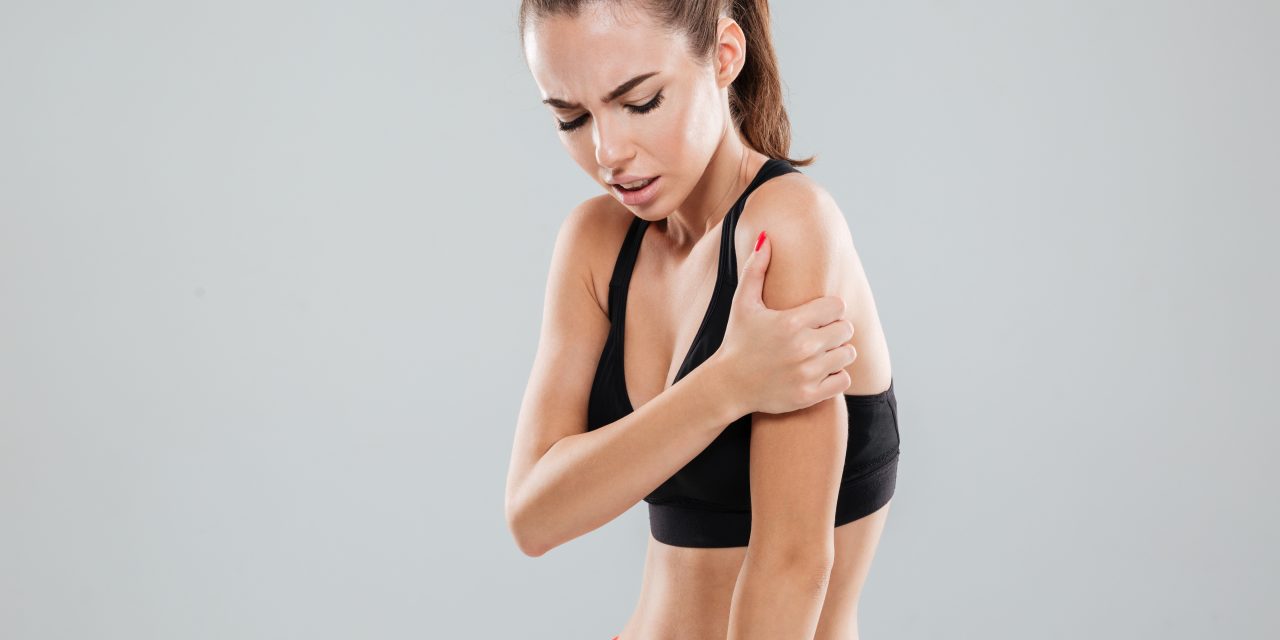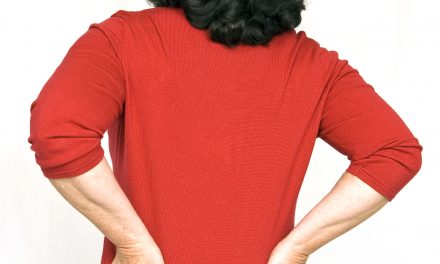
Shoulder Pain

The shoulder is responsible for approximately 16% of all primary care musculoskeletal visits. (1) Many of these patients exhibit an often overlooked, altered scapular position and motion pattern called, “Scapular dyskinesis” (i.e. “winging”) (2,3) In order for clinicians to properly manage shoulder pain, including rotator cuff problems, they must first be able to recognize and treat scapular dyskinesis.
Normal scapulohumeral motion maintains the humeral center of rotation directly above the concave scapular glenoid throughout the shoulders range of motion. This integrated motion between the scapula and humerus provides efficient function and joint stability. (5) When this rhythm is disrupted by abnormal scapular motion, the resulting disproportionate humeral shift creates increased stress on the shoulder capsule and rotator cuff. (5)
Causes of Scapular Dyskinesis
Muscular imbalance, neurologic injury, or joint pathology are potential causes of scapular dyskinesis. The most common origin of scapular dyskinesis is muscular imbalance resulting from a combination of weakness, tightness, fatigue or altered activation. (6) Tightness in the pectoralis minor or short-head of the biceps leads to dyskinesis by placing excessive pull on the corcoid process. (7) It is not completely clear whether pec minor tightness is a causative factor or an adaptive response to scapular malposition. (8) Weakness or fatigue in the lower trapezius or serratus anterior triggers dyskinesis from inadequate acromial elevation. (5,9,10) Dyskinesis can occur from dysfunction in the distal kinetic chain, including hip abductor or core weakness. (52) Hyperkyphosis or “slouched” postures are known contributors. (11-13)
Scapular dyskinesis may be secondary to various shoulder pathology, including AC separation, A/C instability, A/C arthrosis, labral injury, glenohumeral internal derangement, glenohumeral instability, biceps tendinitis, and prior clavicle or scapula fracture. (7,10,14) Neurologic origins of scapular dyskinesis include cervical radiculopathy or peripheral neuropathy. (7,15) Injury to the spinal accessory nerve, long thoracic nerve, or suprascapular nerve is the cause of scapular dyskinesis in approximately 5% of cases. (16)
Shoulder Impingement
Scapular dyskinesis diminishes subacromial space and leads to decreased rotator cuff strength, impingement symptoms, and eventual rotator cuff damage. (17-22) One hundred percent of patients with shoulder impingement demonstrate scapular dyskinesis. (3) Uncoordinated movement of the scapula and humerus leads to a loss of dynamic stability in the glenohumeral joint via excessive strain on the anterior glenohumeral ligaments, with concurrent diminished rotator cuff strength. (3,23-25) Sixty-four percent of patients with glenohumeral instability demonstrate scapular dyskinesis. (3)
Although scapular dyskinesis is linked to a variety of shoulder problems, it may be asymptomatic initially. Up to 76% of healthy college athletes demonstrate some form of asymptomatic scapular asymmetry. (26) The dominant shoulder is affected more frequently. (4) When symptomatic, early complaints can include pain in the anterior or posterosuperior aspect of the shoulder. Discomfort may radiate inferiorly toward the lateral deltoid or superiorly into the trapezius region. Pec minor tightness may generate pain over the corcoid. (27) The consequences of long-standing altered mechanics lead to more well-recognized pain syndromes.
Evaluation
The goal of clinical evaluation is to recognize altered scapular mechanics and identify the underlying causative factors. (9) The acronym “SICK” scapular syndrome has been used to identify the components of scapular dyskinesis, including Scapular malposition, Inferior angle prominence, Coracoid tenderness/malposition, and dysKinesis. (16) Assessment begins with observation for winging (prominence of the inferior angle or medial border of the scapular) or asymmetry. (3) The lateral scapular slide test compares side-to-side measurements of the distance between the inferior angle of the scapula to the adjacent spinous process. The validity of this type of static measurement is open to discussion. (28-30)
Testing
Scapular dyskinesis becomes more apparent with dynamic testing, particularly during the lowering phase of arm movement. (3-28) Literature defines several tests for the dynamic assessment of scapular dyskinesis including the Scapulohumeral rhythm test and Scapular dyskinesis test. (27,32,33) The Scapular dyskinesis test involves a visual assessment of a patient performing weighted shoulder flexion and abduction. The clinician observes for the presence of winging or dysrhythmia (early, excessive, or discoordinated motion).
A range of motion deficit is possible. Posterior shoulder tightness may limit internal rotation, which leads to scapular protraction and dyskinesis- particularly in overhead athletes. Assessment of posterior capsule tightness is performed by measuring internal rotation at 90 degrees of abduction, by having the patient reached behind their back to the highest spinal level, or by assessing horizontal adduction. (34) Internal rotation should be measured while stabilizing the scapula. (35) Palpation may demonstrate tenderness over the coracoid or subacromial region. Trigger points are possible in the pectoral, biceps, upper trapezius, and rotator cuff muscles. Scapular dyskinesis is often part of a larger biomechanical problem- “Upper crossed syndrome”. Clinicians should assess for even more distant origins of instability, including hip abductor weakness.
Treatment
Conservative management is capable of producing significant improvements in pain and function, despite the fact that research shows static and dynamic measurements of scapular dyskinesis remain relatively unchanged after three months of care. (38) The successful management of scapular dyskinesis requires identifying and addressing all of the causative components. Treatment should begin by restoring the flexibility of tightened and hypertonic tissues. Myofascial release and stretching may be necessary for the pec minor, biceps, and upper trapezius. (39-40) Strengthening exercises should be directed at the serratus anterior, lower trapezius, and middle trapezius. (41-43)
The middle and lower trapezius may be strengthened in side-lying forward flexion, external rotation, prone extension, and/or pure horizontal abduction. (44,45) The serratus anterior is activated in various quadruped and push-up positions. (41) Rehab of scapular dyskinesis is most effective when muscles are activated in functional patterns versus isolated strengthening. (46) Functional exercises useful for rehabbing scapular dyskinesis include inferior glide and low row. (47) Strengthening exercises should be performed with the patient focusing on scapular retraction, thereby, increasing serratus anterior and lower trapezius activation. Patients should avoid “shrugging” their shoulders or otherwise activating the upper trapezius. Patients demonstrating weakness in the hip abductors or core musculature may require proximal stabilization prior to implementing more specific scapular stabilization. (48,49) Scapular mobilization may help assist in restoring scapular thoracic mobility. The use of manipulative therapy is a “preferred” treatment that may accelerate recovery. (50,51)
References
1. Van der Windt DA, Koes BW, de Jong BA, Bouter LM. Shoulder disorders in general practice: incidence, patient characteristics, and management. Ann Rheum Dis, 1995;54(12):959-964.
2. Kibler WB, McMullen J. Scapular dyskinesis and its relation to shoulder pain. J Am Acad Orthop Surg,2003;11:142-151.
3. Warner J.J.P, Micheli L.J, Arslanian L.E, Kennedy J, Kennedy R. Scapulothoracic motion in normal shoulders and shoulders with glenohumeral instability and impingement syndrome. Clin Orthop Rel Res. 1992;285:191–199.
4. Oyama S, Myers JB, Wassinger CA, Daniel Ricci R, Lephart SM. Asymmetric resting scapular posture in healthy overhead athletes. J Athl Train. Oct-Dec 2008;43(6):565-570
5. Kibler WB, McMullen J. Scapular dyskinesis and its relation to shoulder pain. J Amer Acad of Orthop Surgeons 2003;11(2):142-151.
6. Cools AM, Dewitte V, Lanszweert F, et al. Rehabilitation of scapular muscle balance. Am J Sports Med 2007;35:1744–51.
7. Borstad JD, Ludewig PM. The effect of long versus short pectoralis minor resting length on scapular kinematics in healthy individuals. J Orthop Sports Phys Ther 2005;35:227–38.
8. Sahrmann S. Diagnosis and treatment of movement impairment syndromes. St Louis: Mosby, 2001.
9. Kibler WB, Ludewig PM, McClure PW, et al. Scapula summit 2009. J Orthop Sports Phys Ther 2009;39: A1–13.
10. McQuade KJ, Dawson JD, Smidt GL. Scapulothoracic muscle fatigue associated with alterations in scapulohumeral rhythm kinematics during maximum resistive shoulder elevation. Journal of Orthopaedic and Sports Physical Therapy. 1998;28(2):74-80.
11. Kebaetse M, McClure P, Pratt NA. Thoracic position effect on shoulder range of motion, strength, and three-dimensional scapular kinematics. Arch Phys Med Rehabil 1999;80:945–50.
12. Finley MA, Lee RY. Effect of sitting posture on 3-dimensional scapular kinematics measured by skin-mounted electromagnetic tracking sensors. Arch Phys Med Rehabil 2003;84:563–8.
13. Gumina S, Di Giorgio G, Postacchini F, Postacchini R. Subacromial space in adult patients with thoracic hyperkyphosis and in healthy volunteers. Chir Organi Mov. Feb 2008;91(2):93-96.
14. Kibler WB, Sciascia AD. Current concepts: scapular dyskinesis. Br J Sports Med 2010;44:300–5.
15. Kuhn J, Plancher K, Hawkins R. Scapular winging. J Am Acad Orthop Surg 1995;3:319–25.
16. Shailen Woods Comprehensive Approach to the Management of Scapular Dyskinesia in the Overhead Throwing Athlete. UPMCPhysicianResources.com/Rehab
17. Seitz AL, McClure P, Lynch SS, et al. Effects of scapular dyskinesis and scapular assistance test on subacromi space during static arm elevation. J Shoulder Elbow Surg 2012;21:631–40.
18. Atalar H, Yilmaz C, Polat O, et al. Restricted scapular mobility during arm abduction: implications for impingement syndrome. Acta Orthopaedica Belgica 2009;75:19–24.
19. Silva RT, Hartmann LG, Laurino CF, et al. Clinical and ultrasonographic correlation between scapular dyskinesia and subacromial space measurement among junior elite tennis players. Br J Sports Med 2010;44:407–10.
20. Smith J, Kotajarvi BR, Padgett DJ, et al. Effect of scapular protraction and retraction on isometric shoulder elevation strength. Arch Phys Med Rehabil 2002;83:367–70.
21. Kibler WB, Sciascia AD, Dome DC. Evaluation of apparent and absolute supraspinatus strength in patients with shoulder injury using the scapular retraction test. Am J Sports Med 2006;34:1643–7.
22. Mihata T, McGarry MH, Kinoshita M, et al. Excessive glenohumeral horizontal abduction as occurs during the late cocking phase of the throwing motion can be critical for internal impingement. Am J Sports Med 2010;38:369–82.
23. Lukasiewicz A.C, McClure P, Michener L, Pratt N, Sennett B. Comparison of 3-dimensional scapular position and orientation between subjects with and without shoulder impingement. J Orthop Sports Phys Ther. 1999;29(10):574–586.
24. Ludewig P.M, Cook T.M. Alterations in shoulder kinematics and associated muscle activity in people with symptoms of shoulder impingement. Phys Ther. 2000;80(3):276–291.
25. Schmitt L, Snyder-Mackler L. Role of scapular stabilizers in etiology and treatment of impingement syndrome. J Orthop Sports Phys Ther. 1999;29(1):31–38
26. Uhl TL, Kibler WB, Gecewich B, Tripp BL. Evaluation of clinical assessment methods for scapular dyskinesis. Arthroscopy. Nov 2009;25(11):1240-1248
27. Postacchini R, Carbone S. Scapular dyskinesis: Diagnosis and Treatment. OA Musculoskeletal Medicine 2013 October 18;1(2)20
28. Kibler WB. The role of the scapula in athletic function. Am J Sports Med 1998;26:325–37.
29. Odom C.J, Taylor A.B, Hurd C.E, Denegar C.R. Measurement of scapular asymmetry and assessment of shoulder dysfunction using the Lateral Scapular Slide Test: a reliability and validity study. Phys Ther. 2001;81(2):799–809.
30. Gibson M.H, Goebel G.V, Jordan T.M, Kegerreis S, Worrell T.W. A reliability study of measurement techniques to determine static scapular position. J Orthop Sports Phys Ther. 1995;21(2):100–106.
32. McClure PW, Tate AR, Kareha S, et al. A clinical method for identifying scapular dyskinesis: part 1: reliability. J Athl Train 2009;44:160–4.
33. Tate AR, McClure PW, Kareha S, Irwin D, Barbe MF. A clinical method for identifying scapular dyskinesis, part 2: validity. J Athl Train. 2009;44:165-173.
34. Kibler B, et al Clinical implications of scapular dyskinesis in shoulder injury: the 2013 consensus statement from the ‘scapular summit’ Br J Sports Med April 2013
35. Awan R, Smith J, Boon AJ. Measuring shoulder internal rotation range of motion: a comparison of 3 techniques. Arch Phys Med Rehabil. 2002;83:1229-1234.
37. Tate AR, McClure PW, Kareha S, Irwin D. Effect of the Scapula Reposition Test on shoulder impingement symptoms and elevation strength in overhead athletes J Orthop Sports Phys Ther. 2008 Jan;38(1):4-11.
38. Struyf F, Nijs J, Mollekens S, Jeurissen I, Truijen S, Mottram S, & Meeusen R (2013). Scapular focused treatment in patients with shoulder impingement syndrome: a randomized clinical trial. Clinical Rheumatology, 32, (1) 73-85.
39. McClure P et al. A randomized controlled comparison of stretching procedures for posterior shoulder tightness.JOSPT.2007;37:108-114.
40. Muraki T et al.Lengthening of the pectoralis minor muscle during passive shoulder motions and stretching techniques: a cadaveric biomechanical study.Phys Ther.2009;89:333-341.
41. Ludewig PM et al. Relative balance of serratus anterior and upper trapezius muscle activity during push-up exercises.Am J Sports Med.2004;32:484-493.
42. Cools AM, Geerooms E, Van den Berghe DF, et al. Isokinetic scapular muscle performance in young elite gymnasts. J Athl Train 2007;42:458–63.
43. Warren Hammer The Scapular Assistance Test Dynamic Chiropractic – November 4, 2004, Vol. 22, Issue 23
44. Cools AM et al. Rehabilitation of scapular muscle balance: which exercises to prescribe? Am J Sports Med.2007;35:1744-1751.
45. de Mey K et al. Trapezius muscle timing during selected shoulder rehabilitation exercises.JOSPT.2009;39:743-752.
46. De May K, Danneels L, Cagnie B, et al. Are kinetic chain rowing exercises relevant in shoulder and trunk injury prevention training? Br J Sports Med 2011; 45:320–1.
47. Ben Kibler et al. Electromyographic Analysis of Specific Exercises for Scapular Control in Early Phases of Shoulder Rehabilitation Am. J. Sports Med. 2008; 36; 1789
48. McMullen J, Uhl TL. A kinetic chain approach for shoulder rehabilitation. J Athl Train 2000;35:329–37.
49. Sciascia A, Cromwell R. Kinetic chain rehabilitation: a theoretical framework. Rehabil Res Pract 2012;2012:1–9.
50. Bergman GJD, Winters JC, et al. Manipulative Therapy in Addition to Usual Medical Care for Patients with Shoulder Dysfunction and Pain. Ann Int Med 2004 141:432-439
51. Winters et al. Comparison of Physiotherapy, Manipulation and Corticosteroid Injection for Treating Shoulder Complaints in General Practice. BMJ 1997
52. Sciascia AD, Thigpen CA, Namdari S, et al. Kinetic chain abnormalities in the athletic shoulder. Sports Med Arthrosc Rev 2012;20:16–21.

















